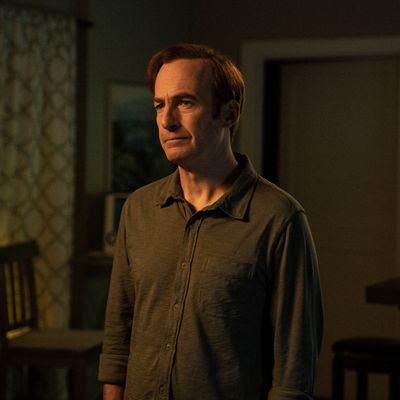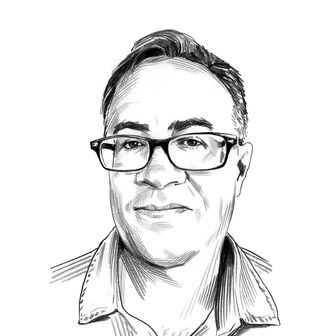
The story lines were inevitably going to converge.
From the beginning of this first half of the final season of Better Call Saul, which picked up with Lalo surviving the assault on his family compound in Mexico, we have been waiting anxiously for him to reemerge in Albuquerque and attempt to have his revenge on Gus. At the same time, we’ve watched Jimmy and Kim work their long con on Howard, following each small step in an elaborate plan to wrest the Sandpiper settlement away from HHM. A meeting between Mike and Kim was a strong indicator that Lalo would find his way back into their lives again, but the how and the when of it were significant question marks. And given the show’s pace and the way these subplots were cordoned off from each other all season, the convergence wasn’t necessarily going to happen now. Or like this.
The creators of Better Call Saul have conned us just as brilliantly as Kim and Jimmy conned Howard, with subtle pieces of misdirection to take such a shocking possibility off the table. In retrospect, that meeting between Mike and Kim functions for us like the trio of obvious Jimmy McGill pranks (the cocaine in the locker room, the Kettleman lawsuit, the prostitute kicked out of the Jaguar) functioned on Howard: to make us think we had a clue about what was going on while a still larger ruse was in motion. We might worry about Kim’s well being specifically since we know she’s not part of the Breaking Bad timeline. We were right to worry, but not about a direct threat Lalo poses to her life. The impact of what actually happened is far more complex — not to mention utterly shocking.
The fun of Better Call Saul — and Breaking Bad before it — is that all the major characters are highly intelligent, thinking several moves ahead on the chessboard, but life nonetheless throws them curveballs. Sometimes they can make adjustments, like scrambling to reshoot the fake bribe photo when Jimmy discovers the real judge has a cast on his arm. That’s fate dealing Jimmy and Kim a playable hand. But fate can be cruel and nonnegotiable, too: If Lalo doesn’t pick up on the fact that Gus has bugged the phones at Casa Tranquila, Howard lives. When Better Call Saul comes back for its final set of episodes in mid-July, there will be questions about all the decisions that led up to this tragic moment, which will have thoroughly knocked Jimmy and Kim off their trajectory. How do they move forward in the short term and the long term? And how do they do it together? (More on those questions in a bit.)
The experience of watching Lalo shoot Howard — a man he doesn’t know and has never met and is simply in the wrong place at the wrong time — reminded me a little of the scene in Pulp Fiction in which Samuel L. Jackson is interrogating a dealer, played by Frank Whaley, and casually shoots the dealer’s friend on the couch. “Oh, I’m sorry, did I break your concentration?” That’s the level of dissonance here because what we’re concentrated on, quite intently, is Howard confronting Jimmy and Kim about the baroque scheme they just pulled on him. Howard is asking them the simple question we might have been asking ourselves about their motives: “Why?” To wit:
“What do you tell yourselves? What justification makes it okay? Howard’s such an asshole that he deserves it? So, what is it? I sided with Chuck too often? I took you away from your office, put you in doc review? Howard’s daddy helped him get to the top, but you both had to struggle. Howie has so much, but we have so little. Let’s take him down a peg or two. What allows you to do this to me?”
Howard has it wrong — or least mostly wrong. There are reasons for them to resent him and want to see him embarrassed. And he’s right to suggest the two of them enjoy pulling off these prankish plots, starting with the time they conned some loudmouth into buying them an expensive bottle of tequila. But the Sandpiper plan also speaks to the nobler side of Kim and Jimmy as lawyers: They want the clients to get speedy justice, Saul Goodman style. Holding out years for a fatter settlement isn’t making Irene and her fellow retirees any more comfortable in their golden years. And Howard’s gross obsequiousness around Irene feels like a kind of bullying: He’s going to get her the chamomile tea with honey she likes and cart out the wheelchair to make her “more comfortable.” He’s going to explain what a mediator does to her as if she’s a child. His reward is the assurance she will do anything her lawyers tell her to do, which is not necessarily the best result for them.
Cliff gets it, too. As Howard scrambles to explain himself after the meeting blows up and vows to continue moving forward with the suit even if it takes them to court, Cliff gives him a reality check. It doesn’t matter, in Cliff’s view, that Jimmy did what he might have done. He says he’s not thinking about Howard or Jimmy but about the additional time and expense of refusing to settle as well as the uncertainty. “I’m thinking about the clients,” he says. That’s where Howard’s motives are so alien from Kim and Jimmy’s motive for practicing law, and he’s not alone. All of the shenanigans last season over the Mesa Verde call center were about finding justice for an old man who didn’t want to leave his house. The system doesn’t serve men like that. And in the case of the Sandpiper suit and HHM, the suit is deemed bigger than the clients.
None of which eases the gut punch of Howard’s death. The staging of the entire sequence is masterful, particularly the device of the candle, which is introduced in the first shot of Kim and Jimmy together, curled up in front of Born Yesterday, and flickering later with Howard’s entrance and, more ominously, Lalo’s. It’s a Steven Spielberg touch to approach danger through reaction shots first: The candle is like that shimmering glass of water in Jurassic Park, and the look on Jimmy’s face before we see Lalo resembles the push-in close-up known as “the Spielberg face.” And really, Kim and Jimmy’s reactions are the ones we’re going to have to sort through as they process this traumatic, life-altering event. Howard’s story ends with shocking abruptness, as crudely decisive as his wife dumping his immaculate coffee drink into a mug.
Where do we go from here? In the immediate term, Lalo needs his lawyers. Then there’s accounting for the murder of a prominent attorney. But it’s Kim’s future that looms largest. She never approved of Jimmy’s dealings with Lalo or other drug pushers and pointedly tossed the shot-up “World’s 2nd Best Lawyer” mug Jimmy had taken such pains to bring back from the desert. Now that she’s witnessed the consequences of Jimmy’s decisions, can she stick around? Before he dies, Howard tells Kim she “has a piece missing.” Is he wrong? Will she realize it? Being worried about Kim is a constant for Better Call Saul fans, but it doesn’t seem as though the possibility of her going the way of Howard should be the biggest concern. There are different kinds of death.
Slippin’ Jimmies
• Fantastic cold open with the reveal that Lalo is surveilling the Lavandería Brillante. The 180-degree pan from the drain where he’s hiding to the laundry across the street was a particularly good touch.
• Speaking of good touches, how about that episode title? “Plan and Execution.” Cold blooded.
• The wonderful actor who plays Lenny, the grocery-store employee and committed thespian, is John Ennis, a cast member from Bob Odenkirk’s rightful beloved HBO sketch series Mr. Show With Bob and David. And the monologue he’s practicing in the parking lot (“I’m not afraid of death. What could death bring that I haven’t faced?”) is from Roy Cohn in Angels in America.
• Delightful speech from our video “auteur” denying his students the good equipment. Of the camera they get to use instead: “Three hundred forty lines of so-called resolution, suitable for recording your sister’s second wedding, local community-board meetings, or porn without plot.”
• Worth thinking about Howard’s line to the intern who hopes one day that someone refers to him, like Howard to Charles McGill, as “the greatest legal mind” they’ve ever known: “Maybe there are more important things,” says Howard.
• I don’t want to undermine Irene’s “chunky” leek suggestion here, but the New York Times’ recipe for leek and potato soup is outstanding. (One important note: The recipe calls for eight cups of water or vegetable stock. Use vegetable stock. It makes a huge difference.)


